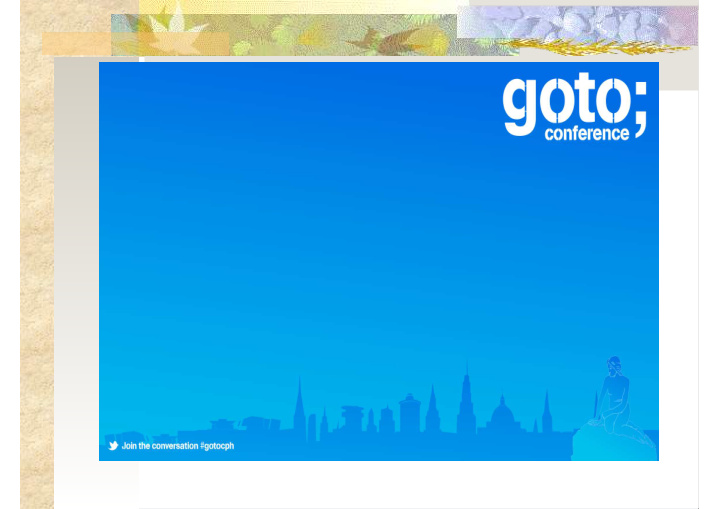



Continuous Retrospectives Linda Rising linda@lindarising.org www.lindarising.org @RisingLinda
Now out ☺ ☺ !
Fearless Journey Game
1998 My first retrospective
Is that a postmortem?
Project Retrospectives A retrospective is an opportunity for the participants to learn how to improve. The focus is on learning—not fault-finding. Norm Kerth
What a retrospective isn’t No naming, no blaming-- naming and praising is encouraged!) Kerth’s Prime Directive: Regardless of what we discover, we must understand and truly believe that everyone did the best job he or she could, given what was known at the time, his or her skills and abilities, the resources available, and the situation at hand.
February 2001 At regular intervals, the team reflects on how to become more effective, then tunes and adjusts its behavior accordingly. agilemanifesto.org/principles.html
Agile Retrospectives How to mine the experience of your software development team CONTINUALLY throughout the life of the project.
Insight ~ what others think Areas of the brain involved in thinking about the future are the same areas involved in thinking about what others are thinking. Right temporoparietal junction RTPJ. Takes a long time to develop ~age 5. To encourage insights, take time off, let the mind wander, listen to others, take another point of view—have a retrospective ☺ ☺ ! See Rebecca Saxe on TED.com
Concrete Action Plan New pattern in More Fearless Change ● Positive images insufficient ● Mental contrasting + ● Implementation intention ● Peter Gollwitzer & Gabriele Oettingen
Cognitive neuroscience Move ● Take a break ● Sleep, naps ● Eat/drink (careful of caffeine) ● Nature ● Environment (animals, babies, plants) ●
Downsides of meeting retros Sitting ● No natural light ● Time-boxed ● Struggle to remember ● Focus on action items – typically sunny ● day thinking
FlowCon 2013 Continuous delivery, continuous ● integration, continuous testing… Continuous retrospectives???? ● I’ve got it backwards! Stop moving ● cognitive neuroscience into retros, instead change retros to take advantage of cognitive neuroscience ☺ ☺ !
But…how to implement it? Small experiments… ● Start with the timeline… ●
Do the timeline in real-time At the start of each iteration, start the timeline ● Do daily stand-ups, other meetings, ● discussions in front of the timeline CONTINUOUSLY post events, ideas for ● experiments, etc. on or near the timeline CONTINUOUSLY reflect and share: what ● went well, what should be done differently – small experiments, puzzles, insights
Which System? System 1: Unconscious (not Freud’s), fast, intuitive/emotional (biased), can multi-task, remembers everything, BUT inaccessible System 2: Conscious, slow, rational, linear, forgetful, chatters constantly while awake, takes energy Both are valuable. Use the one that’s appropriate Daniel Kahneman, Thinking Fast and Slow
Confirmation bias The tendency to search for, interpret, focus on, ● and remember information in a way that confirms one's preconceptions. The best hope for addressing this bias is ● awareness and interacting with diverse others Continuously reflecting and interacting with ● others will test our views and encourage awareness of different viewpoints
Charles Darwin …whenever a published fact, a new observation or thought came across me, which was opposed to my general results, [I made] a memorandum of it without fail and at once; for I had found by experience that such facts and thoughts were far more apt to escape from the memory than favourable ones. Owing to this habit, very few objections were raised against my views which I had not at least noticed and attempted to answer. (Darwin’s timeline)
How continuous reflection works Unconscious mind is involved 24/7 ● Taking a break, sleeping on it ● Walking ● Listening to diverse others ● Posting reduces cognitive load - ● Zeigarnik effect
Current prescriptions for change routinely recommend destabilizing, disruptive approaches. These approaches may be pulled off once, or at most a few times, but repeated attempts to undergo massive change result in burnout, cynicism, and chaos. The Marines have dedicated groups exploring new approaches. As this research pays off in workable concepts, the new ideas are incorporated into Marine practices on an ongoing basis. Thus, the Corps is undergoing constant, gradual change. Even though the change can ultimately be significant, it tends to happen one small step at a time. David Freedman, Corps Business: the 30 management principles of the U.S. Marines
Self-affirmation As reflection becomes continuous we will ● hopefully begin to include consideration of values and goals. Including this practice for only a few ● minutes each day shows benefits. We talk about the end product – the ● Agile Manifesto – but not so much about the process – determining values
Francesca Gino & Bradley Staats Wipro study asked test group of employees going ● through training to spend last 15 minutes writing about, reflecting on lessons learned that day. (Their personal timelines.) Control group kept working for 15 minutes. Did ● not receive additional training. Reflection group increased performance on final ● test by an average of 22.8% over the control group.
Do we need all three? Yes! ● Project – strategic ● Iteration – tactical ● Continuous – small experiments ●
Try your own experiments Use patterns from Fearless Change & More Fearless Change : Just Do It ● Time for Reflection ● Small Successes ● Baby Steps ● Thanks for listening!
Recommend
More recommend